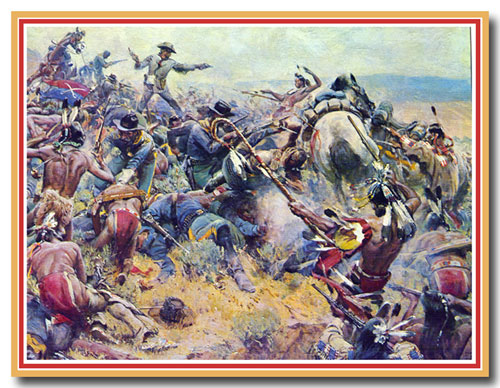Proving the Last Stand

PROVING
THE LAST STAND
William Rini is a teacher, a long-time LBH specialist and a Frontier reenactor.

Concerning Dr. Richard Fox's theories about "no last stand at Little Bighorn (controversial archaeology) : he is clearly an expert in the field of archaeology and forensics, however, it is also quite clear that his weakness is in the area of military tactics and military analysis. I feel he fell far short of the mark concerning the latter.
One great flaw in his theory concerned the alleged lack of organized defense on Custer Hill. There is certainly evidence to suggest otherwise:
1) Concerning the lack of cartridges: any amateur student of the battle could tell you that Last Stand Hill has been more or less picked clean of cartridges and bullets for many years, when the first Superintendant allowed visitors to the battlefield to fill their pockets with souvenirs.
Further evidence pointing to an organized defense on Last Stand Hill is indicated below:
2) there were 32 dead horses (primarily Bays from Co. F) shot and positioned in a semi-circle near the crest of Last Stand Hill, as well as 7 more horses shot as breastworks at the summit.
3) Custer and his Headquarter's Staff were found at the summit, while most of F Co. (including their Commander Capt. Yates and survivors from C, I, & L were found behind the 32 horses just below the summit.
4) the 30 or so troopers who were killed in and around Deep Ravine were nearly all members of E Co., which would indicate a tactical movement to the Ravine, as opposed to a panic-striken rout. Had it been the latter, there would have been an equal number of troopers from F Co. involved as well. Yet nearly all eye-witness account of the bodies in Deep Ravine after the battle identify the soldiers as belonging to E Company.
5) Dr. Fox ignored a number of Indian eye-witness accounts that state very clearly that there was hard fighting (a last stand) in both the Keogh sector and on Last Stand Hill. Of course, we know there was hard fighting on Calhoun Hill for well over an hour before they were overwhelmed by sheer numbers.
6) Dr. Fox also ignores the fact that Custer's 5 companies held off 10 times their number for approximately 2 hours before being overwhelmed, instead relying on a quote claiming the battle lasted "as long as a hungry man eating his dinner." Since when did a hungry man take over 2 hours to eat his dinner?
In short, Custer was on the offensive and was expecting reinforcements at any moment. Had he known that his command had been abandoned by the rest of his regiment, he would have taken a stronger defensive posture. This mistake aided the hostiles greatly in their efforts to penetrate the perimeter. Dr. Fox seems to ignore this critical aspect of the battle completely.
As I said before, Dr. Fox and Dr. Scott are to be commended for doing a great service in uncovering important archaeological clues as the what happened that day, however, I feel that his Achilles heel lies in his attempts to properly interpret military tactical movements and to incorporate them into all of the Indian oral accounts (not just the ones that support a particular theory.) I do think Dr. Fox is right on the money in his analysis of the action at Medicine Tail Ford, and I think his research has opened up a whole new vista supporting the theory that Custer was heading north to reach the non-combatants. They did not mention it, but Dr. Fox has done excellent research demonstrating that Custer actually reached a ford well north of Last Stand Hill, which corroborates the oral account of John Stands-In-Timber, tribal historian of the Northern Cheyenne, and nephew of Wolf Tooth (a battle participant). All in all, he did a very good job, and I recommend his book to all who wish to learn more about this fascinating subject.
see also Indian casualties to understand the strength of Custer's resistance

LITTLE BIGHORN CAMPAIGN
